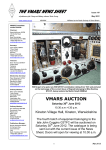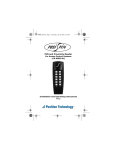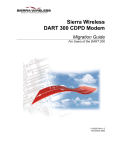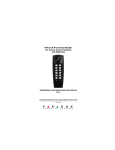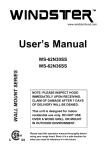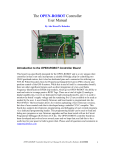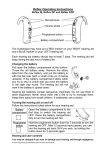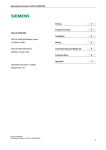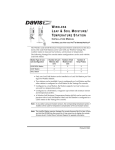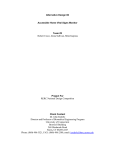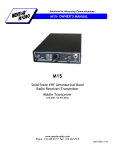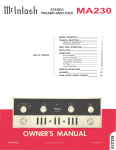Download Radio Link S.R. Mark II Colin Guy, G4DDI
Transcript
VMARS. S.R. Mk 2 Radio Link S.R. Mark II Colin Guy, G4DDI In last year’s members’ survey, we asked if there were any specific equipments about which members would like to see an article; one member mentioned the above equipment. Earlier this year the equipment was mentioned again in conversation with Howard Aspinall, G3RXH, and it is from a user manual kindly loaned to me by Howard that this article has been compiled. Purpose and Facilities This is a specialised wireless apparatus for use in Gun Sound Ranging, both for R.T. communications and for transmission of gun-sound impulses from the special microphone used, to the recording equipment at Headquarters. It replaces wire connections during mobile operations, enabling the sound-ranging “Base” to be deployed more quickly. cases are used to house the set proper and the power supply unit. The vehicle carrier and pack carrying arrangements are identical. The bulk of the components used are common to those used in either the W.S. No.18, No.19 or No.22. Frequency The sets operate on the range from 9 to 10.5 Mc/s in one band. Bandwidth required is 50 kc/s, 20 kc/s above and below the allotted frequency plus an allowance of 10 kc/s for drift and various errors. The Radio Link consists of nine sets, eight of which are outstations and one “Headquarters”. The outstations can be remote controlled from a point up to half a mile distant, and a self contained Loudspeaker Unit is provided for use with the HQ set to enable plotting centre personnel to monitor all speech communications. Power Supply The power supply unit is operated from a 6 volt accumulator. HT and bias supplies are obtained from a three commutator rotary transformer which supplies 60mA at 150 volts and 40mA at 40 volts. The unit also contains the necessary R.F. and A.F. filtering. The valve heaters are supplied from the 6 volt accumulator. The battery drain whether sending or receiving is 6.5 amps. An S.R. Troop in action consists of a Headquarters (where gun sound recording is done), five microphone posts to detect the gun sounds, and two advanced posts to control the recording when once the “base” station is established. R.T. communications are required between H.Q. and all the outstations. In addition an independent one-way channel must be provided between each microphone post and H.Q. where gun sounds are recorded. Layout of Stations Figs. 1 and 2 show the layout of the stations. Tuning Systems. The outstation has a 2-gang condenser which tunes the M.O. circuit (1 section tunes the M.O., the other section is a compensator for the channel spreading) and a 2-gang condenser which tunes the receiver R.F. circuit and local oscillator, 2 single section condensers tune the Buffer stage and Aerial circuit independently. The H.Q. set has 2 single section condensers which tune the L.O. and Aerial circuits independently. The Buffer stage is fixed tuned using a Band pass coil. The receiver has a 2-gang condenser which tunes the R.F. circuit and local oscillator. Principle of Radio Link S.R. Mk.II At the microphone, a single set serves for both speech and gun sounds. When transmitting the latter, the sender frequency is automatically altered by a predetermined amount, depending on the channel being used. There are five channels, see table 1. At H.Q. a special set is used, having a multi channel receiver consisting of a single local oscillator and five I.F. amplifiers, which are tuned 10kc/s apart in frequency. The centre channel is used for speech. The outputs from these channels are connected to the Recorder. In this way the off frequency transmissions from the microphone senders are selected without mutual interference, and are directed to the corresponding galvanometer strings of the recorder. Aerials. The set is designed primarily for use with rod aerials 34’ in length. Aerials shorter than this can be used when working at close range or where the 34’ aerial would be too conspicuous. It must, however, be stressed that successful film recording necessitates as high a signalto-noise ratio as possible; much more so than in the case of ordinary R.T. communications. The longest aerial possible (up to 34’) should therefore be used (consistent with the tactical situation), when working at distances over one mile. At ranges less than one mile, the absence of A.V.C. on the H.Q. receivers renders it liable to overloading from the near station. Table 1 Channel 1 Speech Frequency plus 20kc/s Channel 2 Speech Frequency plus 10kc/s Channel 3 No alteration in frequency Channel 4 Speech Frequency minus 10 kc/s Channel 5 Speech Frequency minus 20 kc/s Construction In construction and external appearance the sets resemble the Wireless Sets No. 22 in that the same C.J. Guy 1 VMARS. S.R. Mk 2 Fig. 1 Fig. 2 C.J. Guy 2 VMARS. S.R. Mk 2 The offending Outstation may have to use a reduced aerial in these circumstances. Reduce by one section at a time until the H.Q. is satisfied. (ii) Understand and carry out the netting drill accurately, remembering that the H.Q. station is always right and his instructions must always be obeyed immediately. When all stations have been netted, H.Q. calls each microphone station in turn to “Press for S.R.,” using prearranged code. Before calling a given station, the H.Q. “METER SWITCH” must be set to the corresponding channel. As each station’s S.R. carrier is received, the corresponding “CHANNEL SENSITIVITY” control is adjusted to give a dip of 50 on the meter. For Channel 3, the “SPEECH S.R.” switch must be pressed to throw the Channel 3 control into circuit. Units Loudspeaking No.1 This is provided for use at S.R. Troop headquarters to enable the Plotting Centre personnel to monitor the communication system without wearing headphones. Also the officer in charge can talk to the HQ set operator (who is wearing headphones) by means of a hand microphone No.4 plugged into the loudspeaker unit. The loudspeaker unit is plugged into the telephone jack on the Recorder S.R., which is in turn connected through the 14-wire connecting cable to the intercommunications systrem in the H.Q. set. The loudspeaker unit is completely self – contained, requiring only a 6 volt accumulator and hand microphone for working. Weights and Dimensions Weight (lbs) 1 2 3 4 Senderreceiver Power unit Senderreceiver and power unit on carrier No. 1 Units Loudspeaking OS HQ 32 35 21 21 67 Operation when Sound Ranging. After establishing the net and adjusting channel sensitivities, the system is ready to record gun-sounds. It is assumed that the Recorder S.R. is ready, and that the recorder operator has set the appropriate attenuators or switches to the “R.L.” position. (1) Location Shoots. H.Q. turns over control of the net to one of the Advanced Posts, which then proceeds to give the group call to find out if he is heard clearly by all other stations. When a record is to be made, control sends “SHOT” (or other pre-arranged code word) which is the signal for all microphone stations to “PRESS FOR S.R.” and for H.Q. to operate “SPEECH-S.R.” switch to “S.R.” The switches will be held operated for a pre-arranged time (say 30 seconds) to allow records to be received from all channels. On releasing the switches, the net returns to normal speech operation. (2) Ranging Shoots. In this case, control remains with H.Q. station, and the Advanced Posts “stand by.” The instant of firing the ranging gun is reported to H.Q. by telephone or otherwise, the time delay before sending “SHOT” can be calculated from available data, and H.Q. operator will be told when to give the signal. Dimensions (ins) Long 17 ½ Deep High 13 ½ 12 7 13 ½ 8½ 70 24 13 ½ 14 16 6½ 12 10 ½ Erecting the Aerial Before you can operate the station a suitable aerial must be erected and connected to the set. (See Figs. 1 and 2). Operation It doesn’t matter how good the wireless sets you are using may be, you will not have good signals or good recordings at H.Q. unless they are all accurately tuned to the same frequency. This point is emphasised with all communication equipment, but must be very strongly emphasised with respect to the Radio Link S.R. Bringing a group of stations on to the same frequency is called “Netting,” and to do it successfully all the operators in the group must:— (i) Know exactly how to tune the wireless set quickly and with confidence. This has been described in the last two sections. Use of Remote Operating Units No. I. The unit is carried inside the power supply unit, and is intended to be employed at Advanced Posts where it would be difficult to conceal the wireless station with its aerial. The unit is used at the observer’s position, and is connected to the set by one or more lengths of 6conductor rubber covered cable. When the station is set up and netted, the cable is plugged into the “REMOTE CONTROL” socket on the panel. The microphone and headphones are disconnected from the set, and plugged into the remote control unit at the Advanced Post. SendReceive switching is done by the pressel switch as before, and no operator is required at the set except to check the tuning, or to change frequency. A remote operating unit is also carried in the H.Q. set to serve as a spare. Circuit Details The outstation (fig. 3) receiver consists of R.F. amplifier V1A (ARP12), local oscillator V1B (ARP12), mixer V1C (ARP12), IF amplifier V1D (ARP12) and detector/avc/output V2A (AR8). The sender consists of M.O. V3B (ARP34), buffer V4A (ATP4), P.A. V4B and V4C (ATP4) and ranging microphone amplifier V3A C.J. Guy 3 VMARS. S.R. Mk 2 (ARP34).The H.Q. station (fig. 4) receiver consists of R.F. amplifier V3A (ARP12), local oscillator V2C (ARP34) and five I.F. amplifiers each consisting of a mixer V3B (ARP12), I.F. amplifier V3C (ARP12) and detector/output V4A (AR8). The I.F. amplifiers are tuned to frequencies spaced 10 kc/s apart. The H.Q. sender consists of M.O. V2B (ARP34), buffer V2A (ARP34) and P.A. V3A (ATP4). Six spare valves are carried in unwired holders inside the outstation sets. It will be seen from the above that this equipment shares much in common with the WS22 and WS62, and anyone familiar with these sets would have no difficulty in making an example of this equipment operational. Final I have never come across an example of this equipment “in the flesh”: my understanding is that, as it doesn’t cover any amateur bands, most of those examples that did find their way onto the surplus market were broken for spares. However, if anyone does have one tucked away, or has a technical manual for it, I would be pleased to hear from them. Also, the manual gives no information about the recording equipment, except a reference to “film”, which implies that it would be an “optical” recorder. If anyone knows anything about this, or how the resulting recordings were used to determine gun positions an article would be most welcome. Fig. 3 Fig. 4 C.J. Guy 4






